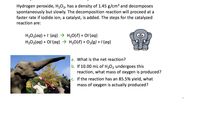
Chemistry
10th Edition
ISBN: 9781305957404
Author: Steven S. Zumdahl, Susan A. Zumdahl, Donald J. DeCoste
Publisher: Cengage Learning
expand_more
expand_more
format_list_bulleted
Question

Transcribed Image Text:Hydrogen peroxide, H₂O₂, has a density of 1.45 g/cm³ and decomposes
spontaneously but slowly. The decomposition reaction will proceed at a
faster rate if iodide ion, a catalyst, is added. The steps for the catalyzed
reaction are:
H₂O₂(aq) + (aq) → H₂O(l) + Ol-(aq)
OO
H₂O₂(aq) + Ol(aq) →
H₂O(l) + O₂(g) +1-(aq)
a. What is the net reaction?
b. If 10.00 mL of H₂O₂ undergoes this
reaction, what mass of oxygen is produced?
c. If the reaction has an 85.5% yield, what
mass of oxygen is actually produced?
Expert Solution
This question has been solved!
Explore an expertly crafted, step-by-step solution for a thorough understanding of key concepts.
This is a popular solution
Trending nowThis is a popular solution!
Step by stepSolved in 3 steps

Knowledge Booster
Learn more about
Need a deep-dive on the concept behind this application? Look no further. Learn more about this topic, chemistry and related others by exploring similar questions and additional content below.Similar questions
- Determine the mechanism (SN1, SN2, E1, or E2) and major product for the reactions below. Consider the type of LG (primary, secondary, or tertiary) AND the reactant type (strong nucleophile, weak base, weak/hindered base) to determine the correct mechanism/product!arrow_forwardFor which of the following reactions would you predict AHxn° 0 ? O O3{g) – O2(g) + O(g) O 5 C(s) + 4 KNO3(s) 5 CO2(g) + 2 N2(8) + 2 K20(s) N2(g) + 3 H2(g) - 2 NH3(g) Pb2+(aq) + SO4²-(aq) – PbSO,(s) O H20(1) H20(g)arrow_forwardBased on the following data, what is the standard Gibbs free energy of formation of the sulfate ion at 298 K?arrow_forward
- Initially, only A and B are present, each at 2.00 mol · L. What is the final concentration of A once equilibrium is reached? Express your answer to two significant figures and include the appropriate units.arrow_forwardIn biological systems, acetate ion is converted to ethyl alcohol as follows: CH3COO–(aq) + 3 H+(aq) + 2e– ----> CH3CHO(aq) + H2O E° = –0.581 V CH3CHO (aq) + 2 H+(aq) + 2e– ------> C2H5OH(aq E° = –0.197 V Find E° and ∆G° for the overall process.arrow_forward12arrow_forward
- AgBr(s) ⇄ Ag+(aq) + Br-(aq) Ksp = 7.7 x 10-13Ag+(aq) + 2NH3(aq) ⇄ Ag(NH3)2+(aq) Kf = 1.5 x 107 When NH3 is added to AgBr(s), a combination of these reactions result:AgBr(s) + 2NH3(aq) ⇄ Ag(NH3)2+(aq) + Br-(aq)What mass of AgBr will dissolve in a 5.0 L container of 2.7 M NH3 solution? * 8.6×100 g * 2.8×10-2 g * 5.2×100 g * 9.2×10-3 g * 4.6×10-2 garrow_forwardCalculate the value of ΔG∘rxnΔGrxn∘ for the following reaction at 294 K. Ka = 2.9 × 10–8 and assume Ka does not change significantly with temperature. HClO(aq)+H2O(l) <--> ClO−(aq)+H3O+(aq)arrow_forwardCan you please answer number 6 and show all of the steps to the solutionarrow_forward
- ' Consider the reaction: 2 NO (g) + O2 (g) → 2 NO2(g) Calculate AGrxn at: a) 25 °Carrow_forwardConsider the reaction below. The reaction quotient for a specific moment is 3.42-10³. If the equilibrium constant is 1.16. 104, what needs to happen in order for the reaction to reach equilibria? Select all that apply. 2 A+ 4 B5 C There will be a net gain in reactant. There will be a net gain in product. The forward reaction will procede more than the reverse reaction. The reverse reaction will occur more than the forward reaction. The system will shift to the left. The system will shift to the right.arrow_forwardWhat is the value of Change in H for this reaction? what is the change in E?arrow_forward
arrow_back_ios
SEE MORE QUESTIONS
arrow_forward_ios
Recommended textbooks for you
 ChemistryChemistryISBN:9781305957404Author:Steven S. Zumdahl, Susan A. Zumdahl, Donald J. DeCostePublisher:Cengage Learning
ChemistryChemistryISBN:9781305957404Author:Steven S. Zumdahl, Susan A. Zumdahl, Donald J. DeCostePublisher:Cengage Learning ChemistryChemistryISBN:9781259911156Author:Raymond Chang Dr., Jason Overby ProfessorPublisher:McGraw-Hill Education
ChemistryChemistryISBN:9781259911156Author:Raymond Chang Dr., Jason Overby ProfessorPublisher:McGraw-Hill Education Principles of Instrumental AnalysisChemistryISBN:9781305577213Author:Douglas A. Skoog, F. James Holler, Stanley R. CrouchPublisher:Cengage Learning
Principles of Instrumental AnalysisChemistryISBN:9781305577213Author:Douglas A. Skoog, F. James Holler, Stanley R. CrouchPublisher:Cengage Learning Organic ChemistryChemistryISBN:9780078021558Author:Janice Gorzynski Smith Dr.Publisher:McGraw-Hill Education
Organic ChemistryChemistryISBN:9780078021558Author:Janice Gorzynski Smith Dr.Publisher:McGraw-Hill Education Chemistry: Principles and ReactionsChemistryISBN:9781305079373Author:William L. Masterton, Cecile N. HurleyPublisher:Cengage Learning
Chemistry: Principles and ReactionsChemistryISBN:9781305079373Author:William L. Masterton, Cecile N. HurleyPublisher:Cengage Learning Elementary Principles of Chemical Processes, Bind...ChemistryISBN:9781118431221Author:Richard M. Felder, Ronald W. Rousseau, Lisa G. BullardPublisher:WILEY
Elementary Principles of Chemical Processes, Bind...ChemistryISBN:9781118431221Author:Richard M. Felder, Ronald W. Rousseau, Lisa G. BullardPublisher:WILEY

Chemistry
Chemistry
ISBN:9781305957404
Author:Steven S. Zumdahl, Susan A. Zumdahl, Donald J. DeCoste
Publisher:Cengage Learning

Chemistry
Chemistry
ISBN:9781259911156
Author:Raymond Chang Dr., Jason Overby Professor
Publisher:McGraw-Hill Education

Principles of Instrumental Analysis
Chemistry
ISBN:9781305577213
Author:Douglas A. Skoog, F. James Holler, Stanley R. Crouch
Publisher:Cengage Learning

Organic Chemistry
Chemistry
ISBN:9780078021558
Author:Janice Gorzynski Smith Dr.
Publisher:McGraw-Hill Education

Chemistry: Principles and Reactions
Chemistry
ISBN:9781305079373
Author:William L. Masterton, Cecile N. Hurley
Publisher:Cengage Learning

Elementary Principles of Chemical Processes, Bind...
Chemistry
ISBN:9781118431221
Author:Richard M. Felder, Ronald W. Rousseau, Lisa G. Bullard
Publisher:WILEY